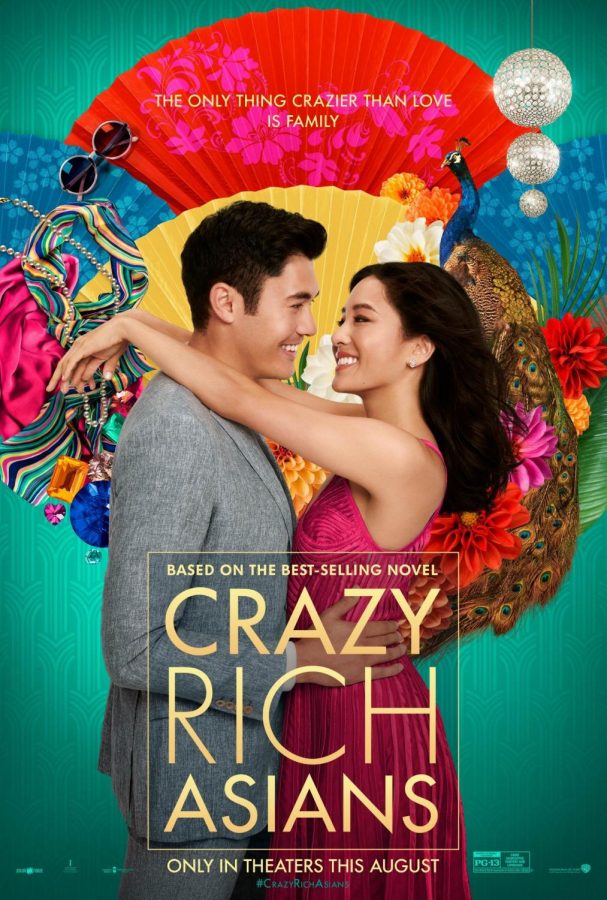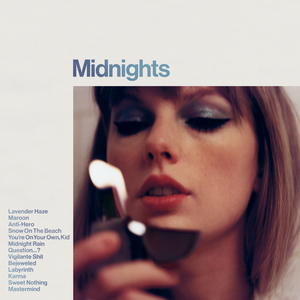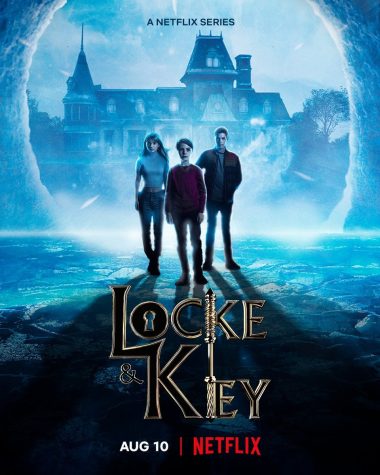Crazy Rich in Meaning: The Rise of Asians in the Media (*spoilers ahead*)
Photo courtesy imdb.com
Crazy Rich Asians poster
I’ve never seen my parents look forward to watching a rom-com as much as my sisters and I — not even for Sandra Bullock in The Proposal. But this movie was different; this time, my whole family was crazy about Crazy Rich Asians.
You might’ve heard of the movie; currently the $117 million dollar reigning champion in the box office and the first Hollywood movie since Joy Luck Club (25 years ago) to feature an all Asian cast. To those who know nothing about the film, the significance of its success is nothing special — rom-coms have had success on the big screen before, re The Proposal. But, for a movie to tell an Asian story with an Asian cast and Asian director and still garner record-breaking success — that is something truly significant. I have never felt the pride that I feel now in knowing people who look and think like me are worth putting front and center on the screen. This pride certainly resonated with my parents and with every Asian and Asian-American I spoke with who watched the movie. After so many setbacks with stereotyping and yellowface, we get to see Asians portrayed with accuracy and captivating three-dimensionality. After all, how can better representation of minorities advance in all aspects of life if the mainstream media doesn’t even represent them well?
For the Asian community and anyone who cares about the representation of an ethnic minority so often overlooked or misunderstood, Crazy Rich Asians is setting an incredible precedent for Asian representation in the media and, in the bigger picture, fostering global appreciation for our culture in the real world.
In Crazy Rich Asians, based on the best-selling book by Kevin Kwan, we dive into the lives of Singapore’s ultra-rich who casually hold lavish Gatsby-esque parties at places like their mansion (the largest piece of private real estate in Singapore), the rooftop infinity pool of the famed Marina Bay Sands resort, and tropical paradise islands a boat ride away in Malaysia. Rachel, played by the lovely Constance Wu, is thrown into this crazy world when she accepts an offer by her boyfriend Nick, son of one of the wealthiest families in Singapore, to meet his parents and attend his friend’s wedding in Singapore. As the protagonist, she faces antagonism as the most ‘American’ character in the story, and is looked down upon for it. Raised by an immigrant single mother, she truly represents the ‘American Dream.’ She was educated at Stanford and works as a talented economics professor at NYU, where she happened to meet Nick. Nick, to Rachel’s surprise and understandable frustration, secretly hails from a famed ‘old-money’ family in Singapore, the Youngs, whose elite social circle revolves around values of propriety, tradition, and exclusivity (think Wharton’s “The Age of Innocence” but with phones and speedier gossip). In the first half of the trip, Rachel, to our dismay, is slut-shamed and shunned by almost all of the socialites for her ‘low’ status, including Nick’s mother Eleanor. By the end, Rachel realizes, with the help of her mother and her best friend, that she must first let Nick go if she loves him — you’ll just have to guess if Nick comes back for her.
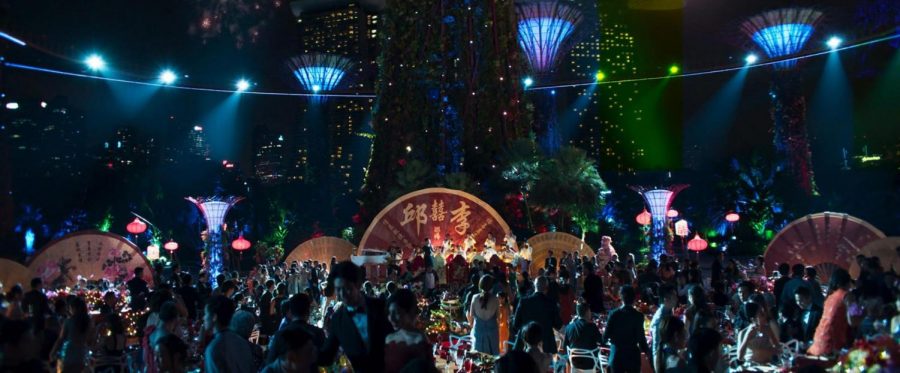
The wedding scene in Crazy Rich Asians.
Just reading the plot summary, you might dismiss this as just a typical rom-com. However, unlike the usual movies, the Asian characters are not foils to the main white protagonists or the victims to endless nerd jokes. On the contrary, the Asians are the protagonists and they beat the usual white rom-coms at their own game: a touching love story that overcomes difficult obstacles, relatable side characters for comic relief, beautiful costumes, and of course, the whole cast is just absurdly attractive. Visually, the movie is stunning. Singapore’s best attractions, namely its dazzling buildings and high status lifestyle, are on display, and they make the usual grand city settings — New York and Paris — pale in comparison. Not only does the movie set this new high standard in the rom-com genre, it’s a breakthrough success in its cultural representation.
What made the movie resonate so deeply with Asian audiences is undoubtedly the many cultural references made throughout the storyline. The soundtrack — golden jazz hits from 1950’s China. The food — bustling street markets and dumpling-making. The traditions — deep respect and obedience to parental figures. And finally, mahjong — the Asian equivalent of poker, which Rachel perfectly uses to finally show down Nick’s mother. All of these aspects add a distinctly rich Asian context to the rom-com. The setting itself was a perfect choice to represent the incredible diversity in Asian culture as Singapore is a cosmopolitan city where multiple Asian cultures intersect, with Chinese, Malaysian, and Indian being just a few. (After all, although I use the word liberally here, ‘Asian’ encompasses cultures from the Middle East border to Japan on the far east). Though I didn’t recognize the Chinese jazz songs like my parents did, I immediately recognized and appreciated every other cultural reference as these references are, in some way, a part of my life: the food that I’ve eaten growing up, the piety expected from me and my sisters to my parents, and mahjong, my grandmother’s favorite game.
More significantly, for a non-Asian viewer, these cultural references might not resonate, but they were portrayed in a way that leaves a lasting positive impression and, hopefully, opened up a window into understanding the beliefs and traditions of a different culture. Take the touchy subject of filial piety. The movie is honest in that it doesn’t hide the crazy high standards and absolutist mindset of the average Asian mother, but it also doesn’t over-exaggerate or mock it. The main mother figure Eleanor undeniably elicits a certain terror and resentment from the viewer in her harsh disapproval of Rachel as her son’s girlfriend, but also a basic level of sympathy for her actions, as we learn later that she was also disapproved of by the grandmother matriarch when marrying into her husband’s rich family. Eleanor’s character becomes nuanced and humanized now that we understand she devoted herself after marriage to micro-managing the family’s affairs and striving for an approval she will never attain. When she tells Rachel “you will never be enough,” an initial instinct to lunge at her for insulting Rachel fades into a realization that she is actually telling her from years of experience to ‘stop now before you get hurt.’ The film clearly understands that the American perception of parenting is not the only correct way to raise a child and, accordingly, succeeds in its careful depiction of the mother character to its primarily American audience.
Crazy Rich Asians doesn’t simply take the easier route but, instead, fully dives into Asian culture in all its richness and still retains its depth and accessibility to the general audience. Culture is expertly woven within the main themes — family, romance, and class — that anyone from any background can find relatable and engaging. The culture simply serves to bring those themes to life.
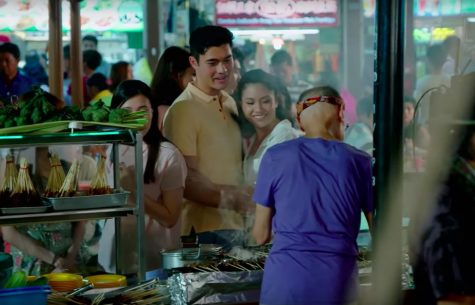
Rachel and Nick get street food in Singapore.
Of course, we can’t ignore the flaws in the movie. The main criticisms that have circulated online argue that the movie is more for Asian-Americans or Americans than Asians, that the movie leaves out South and South-east Asians, and that the movie like other rom-coms idealizes the rich as the only class interesting enough to be portrayed rather than the majority of Singaporeans that are working class. All of these arguments have a certain validity to them. The movie undoubtedly follows the safe well-trodden marriage plot of the romance genre, and because of that, seems to play into the eurocentric and heterosexual ideal of what romance should look like and what a general American or Americanized audience expects. However, as mentioned before, the movie’s success lies in its amazing capability to utilize the rom-com framework and expand upon it with the incorporation of fresh cultural elements — a distinct Asian twist — and rich characters with dynamic relationships. The movie is for Asians, without question, but it only makes sense that in advancing Asian representation, the movie would choose to work with an existing structure that non-Asians can recognize and therefore fully take in its meaning. As for the lack of representation regarding ethnicity and class, these are issues for countless future movies to take on. You can’t expect to fit the entire Asian Diaspora into a two-hour film.
Given the tremendous pressure from Asians and non-Asians alike in the production of this movie, all of the things that the movie did do right makes the question of its wrongs less pressing. Like Jiayang Fan pointedly asks in her New Yorker article on the subject, “What does it mean that ‘Crazy Rich Asians’ must accommodate simultaneous, conflicting demands — to tell a coherent narrative, to represent Asians of all stripes, to showcase Asian culture without alienating the dominant culture, to sell something palatable to the average American — when other movies, starring white leads, are asked only to tell a single story convincingly?” What we should be wondering is not how the movie got this and that wrong, but how the movie got that many things right at all! According to Director Jon Chu and author Kwan, the answer is countless debates, calls, and open discussion.
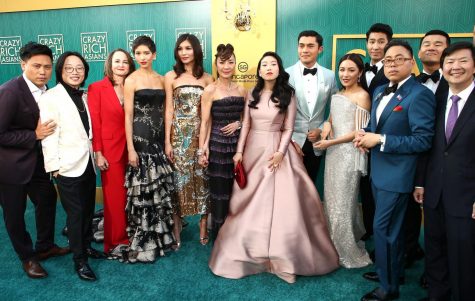
Crazy Rich Asians cast at movie premiere.
The box office success of the movie means economic power and, in the real business world, respect. Jon Chu has proven that an authentically Asian movie can be appealing and meaningful to the average American (This was his goal when he turned down an extremely lucrative offer from Netflix for a movie theatre premiere). Asian culture, openly woven into the story and its world, is something people truly want to see and admire. The ticket sales show for itself. Like Chu has explained, whoever can’t be convinced of the value and power of Asian representation in the media through mere positive reviews can’t deny the cold hard facts of booming ticket sales.
As with any movie, the success of Crazy Rich Asians is not a success solely of its own. The overwhelmingly positive response from the public and from critics doesn’t just happen because of one well-made movie. From a larger perspective, the movie falls on an upward trend of changing social attitudes towards cultural representation marked by other landmarks in the media — Fresh Off the Boat (with Constance Wu herself), Hidden Figures, Get Out, Coco, Black Panther, and recently, Netflix’s movie To All the Boys I’ve Loved being just a few. With each of these massive successes, the movie industry has sparked world-wide discussion of culture and race (and women for the more intersectional films) in the media and with Crazy Rich Asians, the fire keeps burning.

